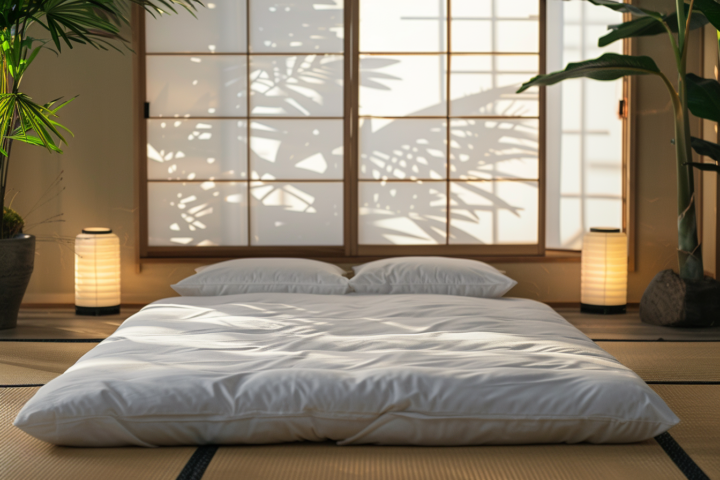
There is a striking cultural divide between East and West where sleeping habits are concerned. We in the West are accustomed to beds raised on frames topped with soft, thick mattresses. Conversely, the Japanese tradition embraces a more grounded approach to sleep, literally, with firm mattresses placed directly on the floor.
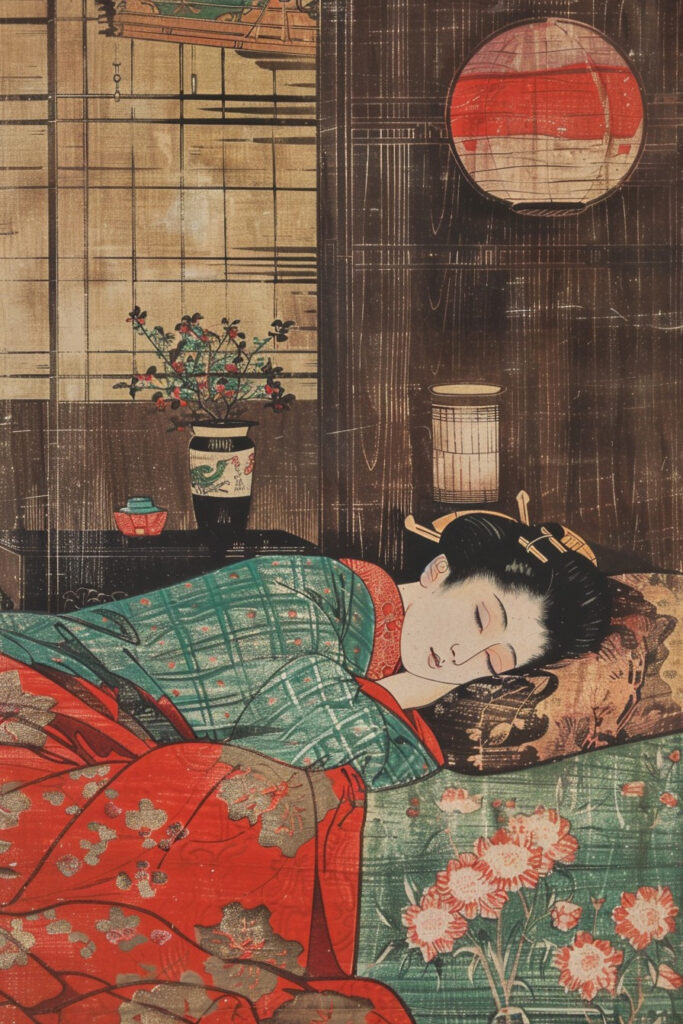
Futon: Traditional Japanese Bed Benefits
A traditional Japanese bed is commonly referred to as a futon. Futons are firm mattresses designed to be laid on the floor and are paired with:
- sobakawa or buckwheat pillows for neck and head support, and
- tatami mats that give another layer of support and promote airflow (preventing mold). They’re sort of like carpets.
1. Versatile and Economical Comfort
Their use dates back to the 17th century, when Japanese homes needed to be versatile. With space at a premium, rooms served various purposes by day and night, necessitating furniture that was as easy to stow away as it was functional. The futon, lightweight and easily moved, emerged as an elegant solution to these space challenges. It was also affordable, making it a popular choice across social strata.
2. Cool Rest
The science is pretty simple: warm air rises. Thus sleeping on the floor will help to keep you comfortably cool all night long as the warm air in your bedroom rises to the ceiling.
3. Enhanced Sleep Posture (Supposedly)
A soft mattress may cause your spine to misalign, potentially resulting in back pain and other problems. It’s true. Many modern mattresses can be excessively soft, causing them to dip in the center. This lack of support for the lower back forces it to bear our weight all night.
Conversely, a firm surface, such as a futon on the floor, supports your spine in a neutral alignment, contributing to better posture overall (and theoretically less discomfort)
However, many studies show that a mattress that is too firm can cause discomfort! So which is it? Is sleeping on the floor good for you or not?
Comfort is subjective.
Some people sleep best on softer surfaces while others perfer firmer ones. Most sleep experts agree that mattress firmness is a personal choice. There is no right mattress for everyone. Thus most mattress companies make a variety of mattresses with varying firmness.
In exploring the history of Japanese sleep hygiene, we can see how our cultural backdrop shapes our perception of comfort. The stark differences in mattress design between eastern and western cultures illustrates that the way we sleep is deeply influenced by the conventions and traditions of society.
So, why do Japanese people sleep on the floor? It’s all about blending tradition, practicality and comfort.
The use of futons on tatami mats isn’t just a nod to cultural heritage; it’s a smart, space-saving choice that can be surprisingly comfy. Plus, it’s a great way to keep things simple and minimalist in the bedroom. This sleeping style, deeply rooted in Japanese culture, offers a unique approach to rest that contrasts with the plush beds we’re accustomed to.
Good night!
Or in Japanese, おやすみ (Oyasumi)

Scientific evidence suggests that regular sauna use can improve sleep by increasing deep sleep cycles, boosting melatonin production, and decreasing stress levels.
I built a sauna in my basement last year and almost immediately noticed that I slept better and longer when I started taking a sauna before bed. I wasn’t aware this was considered one of the benefits of sauna use, but the improvement was obvious to me. Most of us recognize the importance of a good night’s sleep for our health and well-being, so I looked into the science of taking a sauna before bed and its affect on sleep. Sure enough, scentific research reveals a relationship between heat exposure and better sleep. There are a few specific mechanisms at work when understanding how saunas improve sleep.
Sauna Significantly Increases Deep Sleep
Scientific studies indicate that regular sauna bathing can positively impact sleep patterns. Sleep is understood to have three different stages, identified through brain-wave patterns, eye movements, and muscle activity. Non-rapid eye movement (NREM) stage 3 sleep, better known as “deep sleep” or slow-wave sleep is an essential stage for restorative sleep. This stage is believed to be important for physical restoration and cognitive function. Research indicates that heat therapy such as regular sauna use is associated with an increase in deep sleep stages, highlighting its potential as a valuable sleep aid.
Sauna Can Increase Melatonin
Sauna use has been associated with an increase in melatonin production. Melatonin is a hormone produced by the pineal gland in the brain, and it plays a crucial role in regulating the sleep-wake cycle. Several studies have explored the impact of sauna bathing on melatonin levels, suggesting a potential link between sauna use and the modulation of this sleep-regulating hormone.
The body’s circadian rhythms play a vital role in regulating sleep-wake cycles. Sauna use has been linked to the modulation of circadian rhythms, influencing the release of melatonin. A study in Chronobiology International (Leppäluoto et al., 2005), titled “Endocrine effects of repeated sauna bathing,” investigated the hormonal changes induced by sauna bathing. The study observed increased melatonin production following sauna sessions, suggesting a potential mechanism by which saunas contribute to improved sleep onset and maintenance.
Stress Reduction from Sauna Use Before Bed
We all experience stress in day-to-day life. Luckily, the sauna experience is synonymous with relaxation, and its impact on stress reduction is well-documented. Stress and anxiety are significant contributors to sleep disturbances. A study published in the Journal of Applied Physiology (Hannuksela & Ellahham, 2001) highlighted the role of sauna bathing in reducing cortisol levels, the hormone associated with stress. By promoting a state of relaxation, saunas can alleviate stress and, consequently, improve sleep quality.
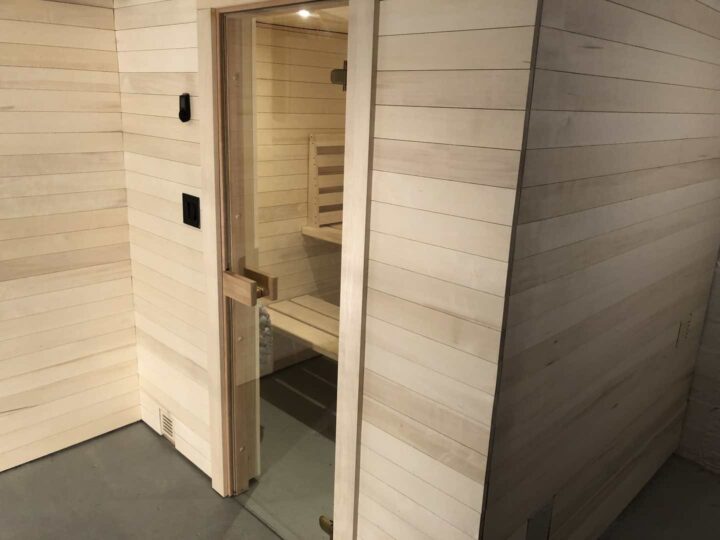
Temperature Regulation and Sleep
Sauna use involves exposing the body to high temperatures followed by a cooling-off period. This process not only induces overall relaxation, but also contributes to a drop in core body temperature. The subsequent cooling phase aligns with the natural decline in temperature that occurs before sleep, potentially promoting better sleep quality.
Do you have to sauna before bed to get sleep benefits?
Studies I read simply research “regular” sauna bathing or heat therapy – measured as some combination of temperature, duration and frequency. It appears that health benefits are especially related to frequency, so more frequent use seems to increase the benefits. It’s not necessary to sauna immediately before bedtime to reap the benefits. In fact, most recommendations are to sauna at least 1-3 hours prior to bedtime to allow your body to completely cool down after heat exposure. I typically sauna in the late afternoon, hours before going to sleep. The key is to use the sauna regularly, at whatever time of day works best for you. While there are no guarantees that using the sauna will cure your insomnia, my personal experience is that my sleep has genuinely improved since making the sauna part of my regular routine.
Sources
- https://pubmed.ncbi.nlm.nih.gov/2578367/
- https://www.ncbi.nlm.nih.gov/pmc/articles/PMC6015540/
- https://pubmed.ncbi.nlm.nih.gov/3788622/
- https://pubmed.ncbi.nlm.nih.gov/11165553/
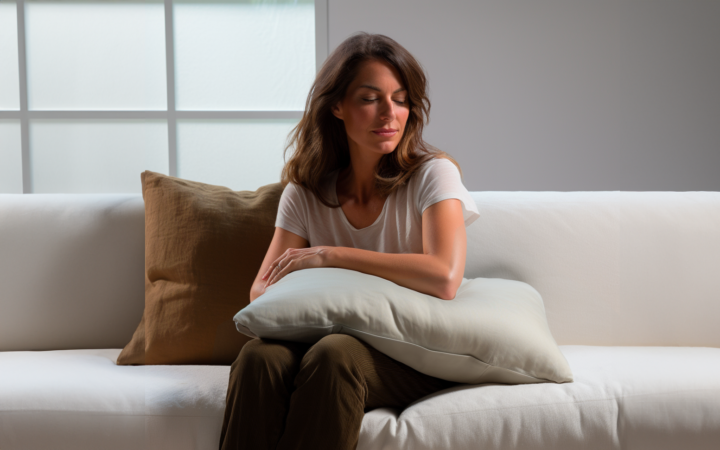
Hugging a weighted pillow is like experiencing a gentle, enveloping embrace. The uniform pressure creates an instant sense of calm and coziness. It’s like a reassuring pat on the back, telling you, “You’re doing great, and everything’s going to be just fine.”
– Luna Dreamweaver, Blissville, CA
The above description might sound a little silly, but it’s surprisingly accurate. Weighted pillows have an uncanny knack for making you feel snug and secure. They may not literally understand your feelings, but the evenly distributed pressure of a weighted pillow does provide a genuine sense of relaxation and tranquility. People love them for a reason, after all!
This feeling is a manifestation of the well-documented principle of Deep Pressure Stimulation (DPS), which has been proven to reduce stress, alleviate anxiety, and enhance overall well-being.
You’ve probably already heard about weighted blankets. Growing awareness of the benefits of DPS and its positive effects on mental health and well-being have made them a very popular story in the media. As these blankets have become more widely available, they’ve garnered a dedicated following. The surge in interest reflects a growing awareness of the importance of self-care and the pursuit of a more balanced and peaceful life, turning weighted blankets into a soothing symbol of modern well-being.
Like their blanket counterparts, weighted pillows apply uniform weight and pressure to the body. Drawing from DPS research and user feedback, these pillows have been found to provide the same comfort and relief that weighted blankets do.
The Magic of Deep Pressure Stimulation (DPS)
Evidence shows that Deep Pressure Stimulation (DPS) offers a myriad of benefits. Apparently it’s the concept of “even pressure” that unlocks its therapeutic potential. Consistent pressure, whether from a weighted blanket, vest, or pillow, activates the body’s parasympathetic nervous system, signaling it to relax and reduce stress. MAGIC!
DPS offers a wide range of benefits, including:
- Stress Reduction: DPS has a calming effect on the nervous system, reducing the production of stress hormones like cortisol, and promoting relaxation.
- Improved Sleep: Many people find that DPS helps them fall asleep faster and enjoy deeper, more restful sleep by reducing restlessness and nighttime awakenings.
- Anxiety Relief: The soothing pressure from DPS can alleviate symptoms of anxiety, promoting a sense of security and tranquility.
- Mood Enhancement: DPS is associated with increased serotonin and dopamine production, which can lead to improved mood and a sense of well-being.
- Sensory Regulation: DPS is beneficial for individuals with sensory processing disorders, such as autism or ADHD, as it can help modulate sensory input and reduce sensory overload.
- Pain Relief: DPS can alleviate discomfort and pain in conditions such as fibromyalgia, arthritis, and muscle tension by promoting relaxation and reducing muscle tension.
- Focus and Attention: Some individuals, particularly those with ADHD, find that DPS can improve focus and concentration.
- Emotional Regulation: DPS can help individuals manage and regulate their emotions by promoting a sense of calm and emotional stability.
What are my weighted pillow options?
Most weighted pillows are filled with materials such as glass beads, plastic pellets, buckwheat hulls, or other dense pillow filling types. The filling in these pillows is notably heftier than the types used in traditional bed pillows.
When purchasing a weighted pillow, several considerations should be taken into account to ensure that it meets your needs and preferences:
- Materials: Pay attention to the materials used in the pillow’s cover. It should be durable and breathable. Weighted pillows are considerably heavier than traditional pillows and thus require a more durable cover. We recommend breathable organic cotton and double-stitched seams!
- Cover Type: Check if the pillow’s cover is removable and machine washable. This feature can make maintenance and hygiene more convenient. A zippered opening that allows the filling to be removed before a wash is a must for most weighted pillows.
- Weight: Weighted pillows come in various weight options, typically ranging from a few pounds to over 10 pounds. Choose a weight that provides the desired level of pressure without feeling too overwhelming.
- Size: Weighted pillows are available in different dimensions, including standard, queen, and king sizes. Consider the size of the pillow in relation to your bed and your own body size for the best fit.
What weighted pillow do we recommend? A Hullo buckwheat pillow of course!
A buckwheat pillow’s unique hull filling makes it an excellent choice as a weighted pillow. The natural weight of buckwheat hulls provides a gentle and evenly distributed pressure. Additionally, buckwheat hull filling is a superior alternative to petrochemical-produced pillow filling like plastic beads for several reasons:
- All-Natural: Buckwheat hulls are a natural, plant-based material, free from potentially dangerous synthetic chemicals.
- Breathability: Buckwheat hulls allow for better air circulation, helping regulate temperature and preventing the buildup of heat and moisture, which can be a concern with some synthetic fillings.
- Eco-Friendly: Choosing buckwheat hulls promotes sustainability as it reduces reliance on non-renewable petrochemical resources. Buckwheat is a 100% Compostable and renewable resource.
- Durability: Buckwheat hulls are known for their long-lasting nature, reducing the need for frequent pillow replacements. Mother earth and your wallet will both approve.
Buckwheat pillows provide a safe and environmentally friendly option for those seeking all the benefits of a weighted pillow. With its all-natural properties, a buckwheat pillow can give a soothing and calming sleep experience, reducing stress and promoting a restful night’s sleep while prioritizing safety and sustainability.
Alternatively, you can make your own weighted pillow.

Choosing the Right Pillow: Your Buckwheat Pillow Buying Guide
Choosing the right pillow is essential for ensuring you get the restful sleep you need. Buckwheat pillows have become increasingly popular in recent years. As a result, a ton of companies have sprung up to sell them. The many different options are overwhelming. In this buckwheat pillow buying guide, we will take a closer look at buckwheat pillows and why our product, Hullo, is the best choice on the market.
Understanding Buckwheat Pillows
Buckwheat pillows are filled with, you guessed it, buckwheat hulls, the outer protective shells of buckwheat seeds. Buckwheat hulls’ unique shape makes it excellent pillow filling. The individual hulls’ rough edges grip one another, enabling your pillow to conform perfectly to the shape of your head and neck, eliminating any uncomfortable pressure points. Traditional pillows can lose their shape and support over time, while buckwheat pillows offer consistent and comfortable support all night long.
Buckwheat hull filling is also breathable. They allow air to circulate through your pillow, keeping you cool throughout the night.
Finding the Perfect Buckwheat Pillow
1. Assessing the Quality of Components
- Fabric case — Opt for a breathable and durable organic cotton fabric that keeps your pillow comfortably cool while preventing rips and tears. Buckwheat hulls are not light (about 10 lb. for a standard size pillow), so your pillow’s seams should be double-stitched. A ripped seam can make quite a mess! Hullo utilizes a 7 oz/yard organic cotton twill fabric, striking the ideal balance between comfort and durability.
- Zipper — a high-quality zipper will keep your pillow’s buckwheat hulls where they belong — inside your pillow. Individual buckwheat hulls are quite small and can get past a cheap non-locking zipper or one that is improperly stitched.
- Buckwheat Hulls — The right hulls for use in a pillow are not easy to find. They should be vacuum-cleaned, intact (not crushed), and of adequate size to ensure breathability. With every purchase of buckwheat hulls from our suppliers, we painstakingly inspect all sources and purchase only the very best available.
Our commitment to quality ensures that your Hullo pillow will last for years, providing excellent support and comfort every night.
2. Emphasizing Sustainability
Sustainability plays a pivotal role in selecting a buckwheat pillow. At Hullo, we prioritize eco-friendly practices throughout our production and shipping processes.
- Renewable and Compostable Materials — Our buckwheat pillows are crafted using renewable, compostable, and organic materials, minimizing their environmental impact compared to traditional pillows that end up in landfills for hundreds of years.
- Durability and Replaceable Filling — Hullo pillows are designed to last, with easily-replaceable filling thanks to its zippered opening. By offering a long-lasting product, we reduce resource consumption and contribute to a more sustainable future.
- Environmentally-Friendly Production and Transportation — From fabric cases to buckwheat hulls and cardboard boxes, Hullo prioritizes locally sourced materials, significantly reducing energy waste and pollution generated during transportation.
3. Additional Benefits: Fast, Free Shipping, and 60-Day Return Window
Hullo ships free via UPS Ground to the 48 Contiguous United States. Every Order. Every Day.
We want you to be completely satisfied with your Hullo pillow, and we stand behind our product with a generous return policy. Try Hullo for 60 nights. If you’re not happy with the sleep you’re getting with Hullo, just ship it back to us and we’ll refund the purchase price.
In conclusion, when it comes to choosing a buckwheat pillow, Hullo is the clear choice. Our commitment to quality, sustainability, and customer satisfaction ensures that you will get a pillow that provides excellent support, lasts for years, and minimizes your environmental impact. Choose Hullo for the best night’s sleep you’ve ever had.

Neck pain can be a real nuisance, and it’s no surprise that people are always looking for ways to alleviate the discomfort. While there are many different types of pillows on the market, buckwheat pillows have become increasingly popular among those seeking relief from neck pain. Let’s explore the benefits of buckwheat pillows and whether or not they are good for neck pain.
What are Buckwheat Pillows?
Buckwheat pillows are filled with buckwheat hulls. Commonly used in Japanese cuisine, buckwheat is a type of grain. People clean and process the outer shells of the buckwheat grain, the hulls, to create a filling for pillows. Buckwheat pillows are a superior alternative to traditional pillows due to the unique qualities of their hull filling.
Benefits of Buckwheat Pillows
Buckwheat pillows have several benefits that make them a popular choice for those with neck pain. First and foremost, the pillows are adjustable. You can adjust the height and firmness of the pillow to suit your needs by moving the buckwheat hulls around inside the pillow. This means that you can create a custom pillow that provides the support you need to alleviate neck pain.
Another benefit of buckwheat pillows is that they are breathable. The hulls allow air to flow through the pillow, which can help keep you cool and comfortable while you sleep. This is especially important if you tend to get hot at night, as traditional pillows can trap heat and make you feel uncomfortable.
Most importantly, buckwheat hulls are malleable. Buckwheat hull filling will conform perfectly to the shape of your head and neck eliminating uncomfortable pressure points, cradling your head consistently all night long.
Will Buckwheat Pillows Help Relieve Neck Pain?
In short, yes, buckwheat pillows can be good for neck pain. They’re adjustable, provide the support you need, and buckwheat hull fill will keep you comfortably cool while you sleep.
It’s worth noting that buckwheat pillows may not be suitable for everyone. Some people find the pillows to be too firm, while others find them too noisy (the hulls can rustle when you move around on the pillow). However, many people have found relief by using buckwheat pillows, so it’s worth giving them a try if you’re looking for a new pillow.
Conclusion
If you suffer from neck pain, a buckwheat pillow may be a good choice for you. These pillows are adjustable, breathable, and above all, comfortable, making them a popular alternative to traditional pillows. While they may not be suitable for everyone, many people have found relief from neck pain by using buckwheat pillows. Consider trying one out to see if it works for you!
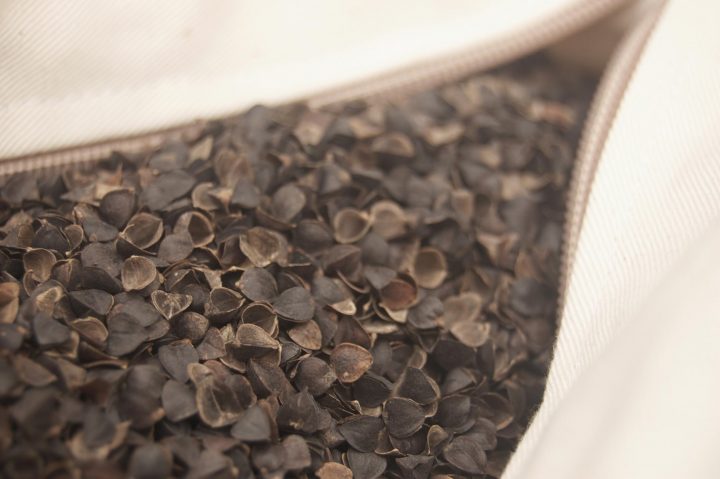
Buckwheat pillows have been gaining popularity in recent years, with many people turning to them as an alternative to traditional down or foam pillows. But are buckwheat pillows comfortable? Let’s explore the features and benefits of buckwheat pillows and help you decide if they’re the right for you…
Firstly, what are buckwheat pillows? Buckwheat pillows are filled with the husks of the buckwheat plant, which are small, triangular-shaped seeds. These seeds are known for their durability, and they don’t compress like traditional pillow fillings. This means that buckwheat pillows can provide better support for your head and neck.
Buckwheat pillow highlights include
- Customizable Support: Buckwheat pillows allow users to adjust the filling to their desired level of firmness and support, providing a personalized sleeping experience.
- Improved Sleep Posture: The natural contours of buckwheat hulls allow for proper spinal alignment and reduced pressure points, resulting in a more comfortable and restful sleep.
- Breathable: Buckwheat hulls allow for air circulation, keeping the pillow cool and dry throughout the night. This can be especially beneficial for people who tend to get hot while sleeping.
- Sustainable and Eco-Friendly: Buckwheat is a renewable resource and its use in pillows reduces waste and supports environmentally responsible practices.
So, are buckwheat pillows comfortable?
The answer largely depends on your personal preference. While some people swear by the support and adjustability of buckwheat pillows, others find them too firm or noisy. The sound of the hulls moving around in the pillow can be a dealbreaker for some.
If you’re considering a buckwheat pillow, it’s important to give it a try before making a purchase. Look for a retailer that offers a trial period, or try a friend’s pillow to get a feel for the texture and support. Keep in mind that it may take some time to adjust to a buckwheat pillow if you’re used to traditional down or foam options.
In conclusion, buckwheat pillows have many benefits that can make them a comfortable option for some people. Their adjustability, breathability, and support make them a great choice for people who struggle with traditional pillow options. However, it’s important to try a buckwheat pillow before making a purchase, as the texture and sound may not be right for everyone.

Hullo™ is obviously comfortable, but it has another benefit: it is a sustainable product. That is, it’s produced in a way that minimizes its impact on the environment and society.
When we started Hullo over 10 years ago, we knew we needed to do it responsibly:
- We make our buckwheat pillows with renewable, compostable, and organic materials. Hullo will not lie in a landfill for hundreds of years like pillows made with petrochemicals.
- Hullo pillows are designed to be durable and include easily-replaceable filling. A long-lasting product reduces resource consumption.
- Hullo is produced and transported using environmentally-friendly methods. The fabric cases, buckwheat hulls and cardboard boxes are produced locally, substantially reducing wasted energy and the pollution generated in transporting goods.
Additionally, we contribute 1% of all our profits to The Nature Conservancy, a nonprofit organization that is dedicated to protecting nature and preserving biodiversity around the world. Many eco-charities do good work, but The Nature Conservancy has proven very effective among its peers.
The Nature Conservancy works to:
- protect critical habitats: The organization protects important habitats for plants and animals, including forests, wetlands, and oceans. By conserving these areas, The Nature Conservancy ensures that these ecosystems continue to function properly and provide valuable services to humans and other species.
- Address climate change: The Nature Conservancy is committed to finding solutions to the climate crisis, which is one of the biggest threats to biodiversity and the health of our planet. They work to promote renewable energy, reduce carbon emissions, and promote sustainable land use practices.
- preserve endangered species: The Nature Conservancy protects endangered species by preserving their habitats, reducing threats from invasive species, and working with local communities to promote conservation.
- promote sustainable agriculture: The organization works with farmers and ranchers to promote sustainable agricultural practices. This helps protect soil health, water quality, and biodiversity.
- support scientific research: They conduct scientific research which helps us better understand the natural world. This research then informs effective conservation strategies.
Please consider making a donation to The Nature Conservancy. You and/or your business can support these important conservation efforts and protect the planet for future generations!
